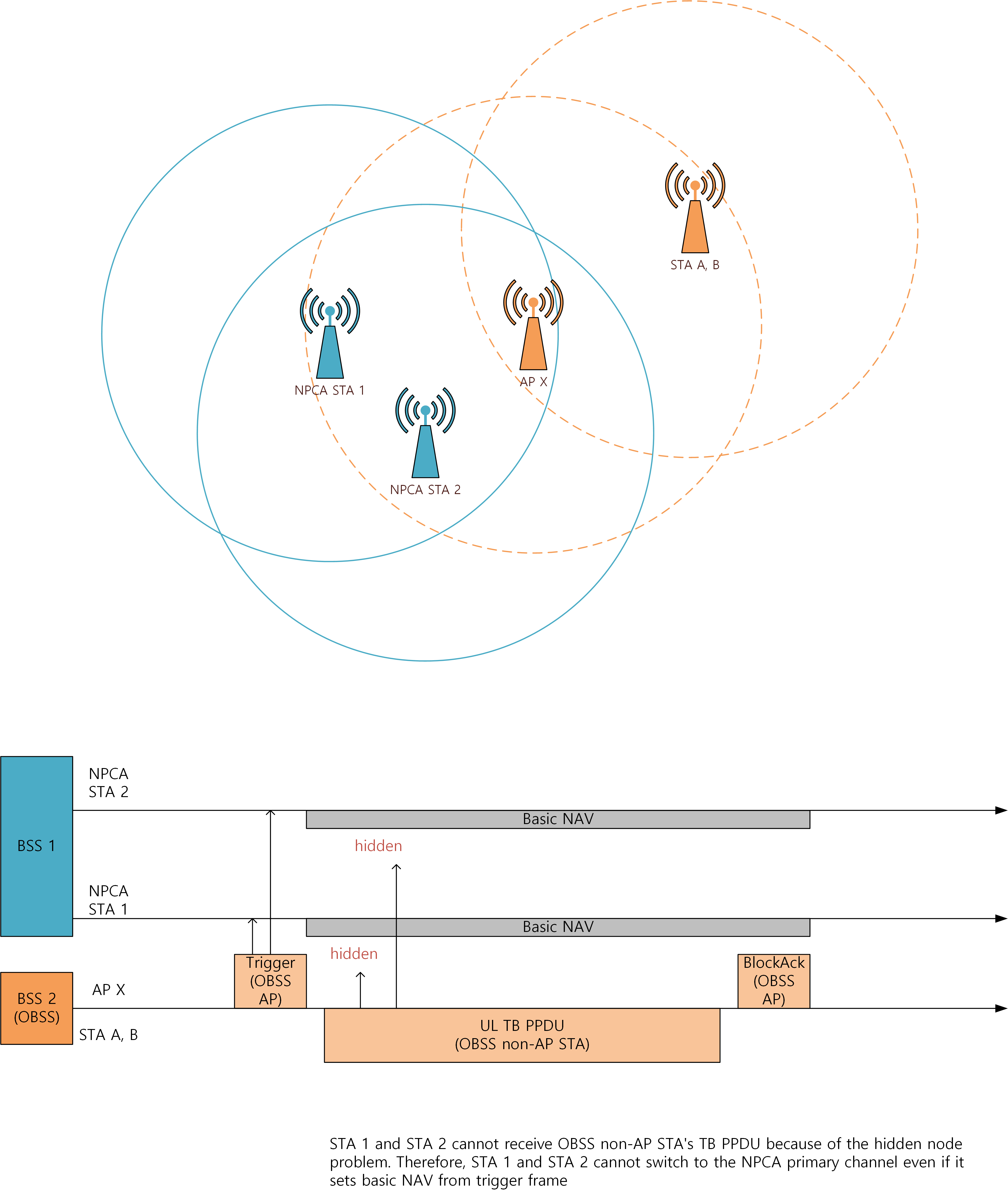I agree that the CTS-to-Self frame is not an ICF (since it does not require a response), and that a subsequent PPDU transmission may trigger channel switching based on Condition 1 after the CTS-to-Self frame.
However, a case of the trigger frame is different. I would like to discuss the triggered UL frame exchange sequence. When a trigger frame is transmitted from an OBSS, the response frame - TB PPDU - is sent after a SIFS duration. This trigger frame can be considered as an ICF, as it initiates a SIFS-separated PPDU sequence of ICF PPDU -> response PPDU -> remaining PPDU.
Regarding the UL TB PPDU exchange sequence, a problematic case can be considered as follows (I also have attached the graphic to explain the problem mentioned in this e-mail.):
(A). NPCA STAs can receive the trigger frame (which is a control frame which solicits immediate response frame and corresponds to the ICF of the condition 2), and set their Basic NAV upon the trigger frame reception.
(B). Due to hidden node problem, NPCA STAs may not receive the TB PPDU, which corresponds to the initial response frame of the condition 2.
(C). As a result, the NPCA STAs, having set their Basic NAV, are unable to access the medium while the OBSS is conducting the TB PPDU exchange.
(C)-1. If any NPCA STA which can receive TB PPDU, it will falls under the condition 1 and may switch to the NPCA primary channel. However, the hidden node environment will make the problem which I explained above. Because of the problem, the NPCA STA which switched to the NPCA primary channel may not perform frame exchange with other NPCA STAs which cannot switch to the NPCA primary channel in (C). Also, as you know, the current PDT is considering the hidden node environment as quoted and underlined below:
"
2) All of the following conditions are true:
a) A sequence of three PPDUs, separated by aSIFSTime, is identified on the BSS primary channel, comprising an initial Control frame, an initial response frame and a third PPDU following the initial response frame
b) The STA received at least the first PPDU containing the initial Control frame and the PHY-RXSTART.indication and/or the PHY-RXEARLYSIG.indication of the third PPDU
“
In (A), the NPCA STAs shall set their basic NAV based on duration information of the trigger frame from the OBSS. Also, the non-AP STA(s) of the OBSS shall set intra-BSS NAV based on the trigger frame. Even if the TB PPDU in response to the trigger frame is not transmitted, due to the intra-BSS NAV, the OBSS non-AP STAs cannot transmit the frame, while the OBSS AP can retry frame transmission before its TXNAV expires. In other words, the NPCA STAs cannot use both the primary channel and the NPCA primary channel during the OBSS performing the UL TB PPDU exchange, following the current PDT.
I think the NPCA operation shall be performed in case of the UL TB PPDU exchange for the better channel utilization. In my opinion, the current PDT should be modified to consider the case I explained above.
If you have further opinions, please let me know.
Thank you.
Best regards,
Juseong Moon

2025. 7. 1. 오전 8:50, Matthew Fischer <matthew.fischer@xxxxxxxxx> 작성:Juseong,A careful reading of the r7 text should provide your answer:If the OBSS sequence does not contain 3 PPDUs, then only condition 1 can be met, and if condition 1 is met, then only PHY header information can be used for NPCA.Your example case seems to include only 2 PPDUs, so condition 2 cannot be satisfied.Even if you examine a 3 PPDU sequence of: CTS2SELF, Trigger, TB PPDU, condition 2 would still not be satisfied, because the 1st PPDU needs to be an initial control frame, and CTS2SELF is not an initial control frame(Anyway, I believe it is not!)On Fri, Jun 20, 2025 at 8:05 AM 문주성 <theonebird81@xxxxxxxxx> wrote:Hi Matthew, I'm Juseong Moon, affiliated with KNUT. I would like to clarify a point regarding your NPCA CR document. If the basic NAV is set due to an OBSS data transmission that begins with a CTS-to-Self or Trigger frame, which NPCA procedure should be applied in this case—PHY header-based or MAC header-based? Best regards, Juseong Moon2025년 6월 19일 (목) 오후 12:05, Matthew Fischer <matthew.fischer@xxxxxxxxx>님이 작성:In response to various comments received, a new revision is available.--Matthew FischerBroadcomTo unsubscribe from the STDS-802-11-TGBN list, click the following link: https://listserv.ieee.org/cgi-bin/wa?SUBED1=STDS-802-11-TGBN&A=1
--Matthew Fischer
To unsubscribe from the STDS-802-11-TGBN list, click the following link: https://listserv.ieee.org/cgi-bin/wa?SUBED1=STDS-802-11-TGBN&A=1